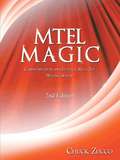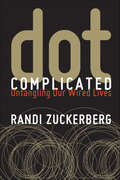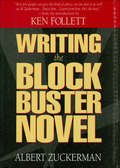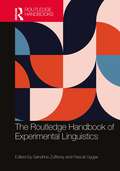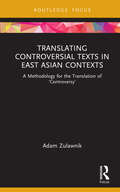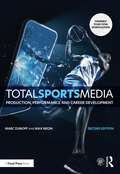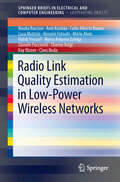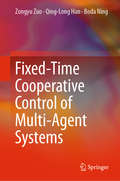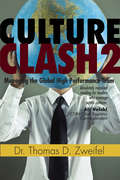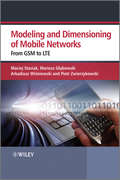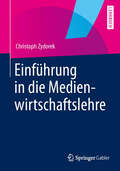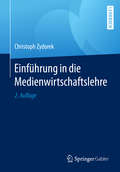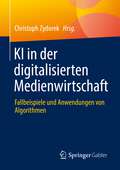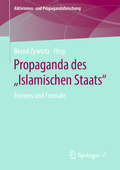- Table View
- List View
MTEL Magic: Writing Subtest
by Chuck ZuccoThe name of this book is a misnomer. There really is no magical solution to taking this or any other test. What makes this book different is that it presents a simple formula for passing-skills + strategies + practice = success.
Dot Complicated: Untangling Our Wired Lives
by Randi ZuckerbergWith Dot Complicated: Untangling Our Wired Lives, new media pioneer Randi Zuckerberg offers an entertaining and essential guide to understanding how technology and social media influence and inform our lives online and off.Zuckerberg has been on the frontline of the social media movement since Facebook’s early days and her following six years as a marketing executive for the company. Her part memoir, part how-to manual addresses issues of privacy, online presence, networking, etiquette, and the future of social change.
Writing the Blockbuster Novel
by Al ZuckermanEvery novelist dreams of it--writing the book that rockets to the top of the best-seller lists. Now, they can see how it's done, up close, in a book by an agent who has sold manuscripts that turned into hits.<P><P> Here Albert Zuckerman covers the essential elements of the blockbuster novel and shows writers how to put them to work in their books. Zuckerman covers the subject thoroughly, from creating outlines and building larger than life characters to injecting suspense and more. His instruction is decisive, direct and clear and is supported with examples from Gone With the Wind, The Godfather and other blockbusters.
The Routledge Handbook of Experimental Linguistics (Routledge Handbooks in Linguistics)
by Sandrine Zufferey Pascal GygaxThe Routledge Handbook of Experimental Linguistics provides an up-to-date and accessible overview of various ways in which experiments are used across all domains of linguistics and surveys the range of state-of-the-art methods that can be applied to analyse the language of populations with a wide range of linguistic profiles. Each chapter provides a step-by-step introduction to theoretical and methodological challenges and critically presents a wide range of studies in various domains of experimental linguistics. This handbook: • Provides a unified perspective on the data, methods and findings stemming from all experimental research in linguistics • Covers many different subfields of linguistics, including argumentation theory, discourse studies and typology • Provides an introduction to classical as well as new methods to conduct experiments such as eye tracking and brain imaging • Features a range of internationally renowned academics • Shows how experimental research can be used to study populations with various linguistic profiles, including young children, people with linguistic impairments, older adults, language learners and bilingual speakers Providing readers with a wealth of theoretical and practical information in order to guide them in designing methodologically sound linguistic experiments, this handbook is essential reading for scholars and students researching in all areas of linguistics.
Translating Controversial Texts in East Asian Contexts: A Methodology for the Translation of ‘Controversy’ (Routledge Advances in Translation and Interpreting Studies)
by Adam ZulawnikZulawnik focuses on the broad concept of ‘controversy’ and issues pertaining to the translation of politically and historically controversial texts in East Asia. The research methodology is exemplified through a case study in the form of the author’s translation of the best-selling Japanese graphic novel (manga) Manga Kenkanryū (Hate Hallyu: The Comic) by Sharin Yamano (2005), a work that has been problematised as an attack on South Korean culture and the Korean Wave. Issues analysed and discussed in the research include translation risk, ethics, a detailed methodology for the translation of so-called controversial texts exemplified through numerous thematically divided examples from the translation of the chosen Japanese text, as well as examples from a Korean language equivalent (Manhwa Hyeomillyu – Hate Japanese Wave), and definition and contextualisation of the concept of ‘controversy’. There has been limited research in the field of translation studies, which seeks to exemplify potential pragmatic approaches for the translation of politically-charged texts, particularly in multi-modal texts such as the graphic novel. It is hoped that Zulawnik’s research will serve both as a valuable source when examining South Korea–Japan relations and a theoretical and methodological base for further research and the development of an online augmented translation space with devices specifically suited for the translation of multi-modal texts such as – but not limited to – graphic novels and visual encyclopaedias.
Total Sports Media: Production, Performance and Career Development
by Marc Zumoff Max NeginThis thoroughly revised second edition of Total Sports Media (formerly Total Sportscasting) offers a complete guide to sports media across TV, radio and digital broadcasting. Covering everything from practical skills to industry lingo, this book guides readers through each aspect of the sportscasting process, including performance and production techniques, demo reel production, and writing for sports media. Chapters feature interviews with successful sports media professionals who take you inside the real-world practices of the industry, offering invaluable insights on how to carve out a career in the field and forge lasting relationships with team personnel. New to this edition are a discussion of changes in the industry as a result of the Covid-19 pandemic, updated sections on career paths and professional development opportunities, and an updated chapter on social media strategies for sportscasters. This book also delves into the unique issues facing women and minority sportscasters. Finally, the authors look at the history of sports media and discuss the future of the industry. Total Sports Media is an essential resource for both students and instructors of sports media, as well as for industry professionals interested in a wide-reaching look at this changing field. A companion website features additional resources for instructors and students, including video and audio examples and links to additional resources.
Radio Link Quality Estimation in Low-Power Wireless Networks
by Marco Antonio Zuniga Carlo Alberto Boano Claro Noda Luca Mottola Habib Youssef Hossein Fotouhi Daniele Puccinelli Anis Koubâa Kay Römer Mário Alves Nouha Baccour Thiemo VoigtThis book provides a comprehensive survey on related work for radio link quality estimation, which covers the characteristics of low-power links, the fundamental concepts of link quality estimation in wireless sensor networks, a taxonomy of existing link quality estimators and their performance analysis. It then shows how link quality estimation can be used for designing protocols and mechanisms such as routing and hand-off. The final part is dedicated to radio interference estimation, generation and mitigation.
Fixed-Time Cooperative Control of Multi-Agent Systems
by Zongyu Zuo Qing-Long Han Boda NingThis monograph presents new theories and methods for fixed-time cooperative control of multi-agent systems. Fundamental concepts of fixed-time stability and stabilization are introduced with insightful understanding. This book presents solutions for several problems of fixed-time cooperative control using systematic design methods. The book compares fixed-time cooperative control with asymptotic cooperative control, demonstrating how the former can achieve better closed-loop performance and disturbance rejection properties. It also discusses the differences from finite-time control, and shows how fixed-time cooperative control can produce the faster rate of convergence and provide an explicit estimate of the settling time independent of initial conditions. This monograph presents multiple applications of fixed-time control schemes, including to distributed optimization of multi-agent systems, making it useful to students, researchers and engineers alike.
Culture Clash 2: Managing the Global High Performance Team
by Thomas D. ZweifelFew are prepared for managing across cultures, and the costs of cultural blind spots can spin out of control-from lawsuits to lost opportunities. Forged in the fire of clashing cultures and living on four continents, Dr. Zweifel developed a fool-proof methodology for managing successfully across borders. And post-9/11, the Arab Spring and the BRICS emerging markets, e-commerce and social networks have made this updated and expanded edition of Culture Clash indispensible. Culture Clash 2 is not another Kiss, Bow or Shake Hands. Such protocol-laden works on whether to bring wine to a dinner in Singapore or how many times to kiss in France might have their uses, but non-compliance with local etiquette has rarely been a deal-breaker. What has derailed international business is the inability of managers to see the world from their counterpart's point of view, read between the lines, and decode the mind-set of the other side.
Modelling and Dimensioning of Mobile Wireless Networks
by Piotr Zwierzykowski Arkadiusz Wisniewski Mariusz Glabowski Maciej StasiakThis book is a must-read for all network planners and other professionals wishing to improve the quality and cost efficiency of 3G and LTE networksIn this book, the authors address the architecture of the 2/3G network and the Long Term Evolution (LTE) network. The book proposes analytical models that make the analysis and dimensioning of the most important interfaces, i.e. WCDMA or Iub, possible. Furthermore, the authors include descriptions of fundamental technological issues in 2/3 G networks, basic traffic engineering models and frequent examples of the application of analytical models in the analysis and dimensioning of the interface of cellular networks. The specific knowledge included in the content will enable the reader to understand and then to prepare appropriate programming softwares that will allow them to evaluate quality parameters of cellular networks, i.e. blocking probabilities or call losses. Additionally, the book presents models for the analysis and dimensioning of the Wideband Code Division Multiple Access (WCDMA) radio interface and the Iub interface, both carrying a mixture of Release 99 traffic (R99) and High-Speed Packet Access (HSPA) traffic streams. Finally, the analytical models presented in the book can be also used in the process of modeling and optimization of LTE networks.Key Features:Describes the architecture and the modes of operation of the cellular 2/3/4G systems and the LTE network Covers the traffic theory and engineering within the context of mobile networks Presents original analytical methods that enable their users to dimension selected interfaces of cellular networks Discusses models for the analysis and dimensioning of the Wideband Code Division Multiple Access (WCDMA) radio interface and the Iub interface, both carrying a mixture of Release 99 traffic (R99) and High-Speed Packet Access (HSPA) traffic streams Includes problems as well as an accompanying website containing solutions, software tools and interactive flash animations (http://wiley.teletraffic.pl) This book will be an invaluable guide for professional engineers (radio planning engineers, optimization engineers, transmission engineers, core network engineers, Service Management engineers) working in the areas of mobile wireless networks technology, not only in optimization process, but also in profitability assessment of newly implemented services (i.e. in NPV - Net Present Value analysis), and researchers and scientists. Advanced students in the fields of mobile communications networks and systems will also find this book insightful.
Einführung in die Medienwirtschaftslehre
by Christoph ZydorekWelche medienökonomischen Anknüpfungspunkte haben speziell Studierende als Abnehmer und künftige Produzenten von Medien? Diese Einstiegsfrage verdeutlicht auf einfache Weise die Sinnhaftigkeit einer systematischen Durchdringung des Themas Medienökonomie und führt die wichtigsten Begriffe ein: Medien, Inhalt, Wertschöpfung, Güter, Bedürfnisbefriedigung mit Medien, Medien als Wirtschafts- und Kulturgüter. Christoph Zydorek stellt die drei Haupt-Akteurstypen (Rezipient, Medienunternehmen, werbetreibende Wirtschaft) auf Medienmärkten mit ihren jeweiligen Handlungsmotivationen sowie danach die zentralen Eigenschaften von Mediengütern vor. Darauf aufbauend können einige Mainstream-Handlungskonzepte aus der Sicht der Hersteller von Mediendienstleistungen diskutiert werden: Preis- und Erlöspolitik, Bündelung, Versionierung, Windowing. Das Lehrbuch dient als Einführung in die Grundfragen und als Vorbereitung auf eine tiefergehende Durchdringung des medienwirtschaftlichen Handlungsbereichs.
Einführung in die Medienwirtschaftslehre
by Christoph ZydorekDas Lehrbuch dient als Einführung in die Grundfragen und als Vorbereitung auf eine tiefergehende Durchdringung des medienwirtschaftlichen Handlungsbereichs. Welche medienökonomischen Anknüpfungspunkte haben speziell Studierende als Abnehmer und künftige Produzenten von Medien(inhalten)? Diese Einstiegsfrage verdeutlicht auf einfache Weise die Sinnhaftigkeit einer systematischen Durchdringung des Themas Medienökonomie auf dem Niveau einer Einführung für das Grundstudium in Medienstudiengängen. Das Lehrbuch führt die wichtigsten Begriffe ein: Medienträger, Content, Wertschöpfung, Güter, Bedürfnisbefriedigung mit Medien, Medien als Wirtschafts- und Kulturgüter. Christoph Zydorek stellt die drei Haupt-Akteurstypen (Rezipient, Medienunternehmen, Werbetreibende Wirtschaft) auf Medienmärkten mit ihren jeweiligen Handlungsmotivationen sowie die zentralen Eigenschaften von Mediengütern vor. Die 2. Auflage wurde grundlegend überarbeitet und aktualisiert.
KI in der digitalisierten Medienwirtschaft: Fallbeispiele und Anwendungen von Algorithmen
by Christoph ZydorekDie Entwicklungstrends in der fortschreitenden Algorithmisierung des Mediensektors werden in diesem Band für verschiedene Teilsektoren der Medien (Games, Musik, Bücher, Audio/Video, Nachrichtenmedien) anhand aktueller Beispiele aus der Forschung, der Entwicklung und der Praxis der Medienwertschöpfung demonstriert. Es erweist sich, dass zunehmend mehr und größere Tätigkeitsbereiche, die früher ausschließlich durch menschliche Arbeitsleistung, professionelle Gestaltungskompetenz und Kreativität geprägt waren, durch unterschiedliche Formen automatisierter und zunehmend „intelligenter“ Routinen übernommen werden. Die diesen Routinen innewohnenden ökonomischen Rationalisierungspotenziale treiben den Prozess der Ersetzung menschlicher Arbeit durch Kapital in der Wertschöpfungskette der Medieninhalte schnell und tiefgreifend voran.
Propaganda des „Islamischen Staats“: Formen und Formate (Aktivismus- und Propagandaforschung)
by Bernd ZywietzDie Propaganda der terroristischen Miliz „Islamischer Staat“ hat für Aufsehen gesorgt und die Debatte um das Internet und vor allem das „Social Web“ als Risikotechnologie oder Gefahrenraum mitbestimmt. Dabei setzt der IS auf ein breites Spektrum medialer und gestalterischer Formen und Formate einer globalen, digitalen Medienkultur, um ein internationales Publikum zu erreichen: Online-Videos, anashid (Lieder) und Computerspiele; Internet-Meme, Social Media Posting oder Selfies. Der Sammelband gibt Einblick in die Bandbreite dieser jihadistischen Kommunikate, ihrer Ausdrucks- und Darstellungsweisen und zeigt dabei Möglichkeiten der Einordnung und der Auseinandersetzung auf.
